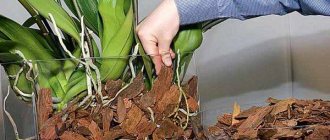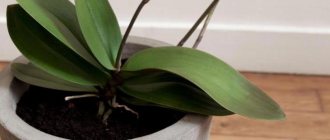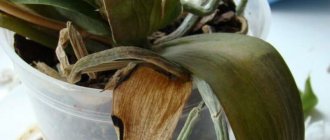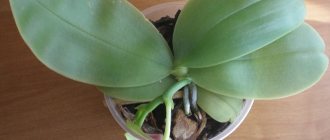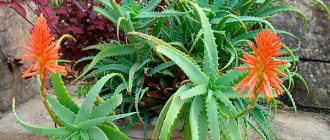Orchids strewn with buds are not uncommon for a flower shop. But achieving repeated flowering (even if not so abundant) at home can be difficult. What kind of care do epiphytes need so that they regularly form buds?
The trend of giving potted orchids instead of a traditional bouquet is gradually waning. But even without this, almost every home has at least one tropical plant (for example, phalaenopsis, vanda, dendrobium, cymbidium, etc.). Someone managed to make friends with capricious epiphytes and achieve almost continuous flowering. Some people are happy with 3-4 flowers on a single arrow. And some even have to observe only stringy leaves and aerial roots from year to year.
When does flowering occur at home?
Different varieties of orchids begin to bloom at different ages . Usually the first buds appear when the flower is 1.5-3 years old. You can find out the age of an orchid by its shoots: if the plant is 2 years old or more, then there should be at least 5-8 of them.
Attention : Botany knows more than 30 thousand natural varieties of flowering orchids and the same number of artificially bred species of this plant.
After the orchid has bloomed and its peduncle has dried, you can wait for the next flowering no earlier than in 2-3 months. This fact is due to the fact that a healthy plant, with proper care, can generate flower stalks only 2-3 times a year , and the duration of flowering itself is usually about 3 months. However, not all orchids obey the general rules, and the reason for this is often the incorrect conditions of their maintenance and the owners’ ignorance of how to act correctly to achieve flowering.
Orchid care after flowering
When the orchid has stopped blooming, do not rush to cut off the peduncle. Firstly, after a while, dormant buds may awaken on it. Secondly, the flower stalks have a growing tip. If it stays green, there's a good chance it will continue to grow and produce new buds. This can happen during flowering or 1-3 months after the flowers fall off. There is also a possibility that the tip of the peduncle will not grow.
If the tip has turned black, yellowed or shriveled, the peduncle can be removed - completely or only the part where the flowers were (in the place just above the last dormant bud). Many breeders leave all flower stalks, because... This way it’s easier to achieve repeated flowering, because each bud can form a lateral peduncle or a baby. But keep in mind that by leaving the old peduncle, you slow down the development of new ones. But the decorative effect of a blossoming orchid on a new shoot is much higher than if the buds appear on a side shoot.
If a peduncle with a cut off tip begins to dry out or turn yellow, it must be removed. You should leave only a small “stump” with at least one bud.
A frequently asked question is whether it is possible to replant a blooming orchid. It is better not to do this, since at this time the orchid will again experience stress. Transplantation should be postponed until the plant has completely flowered. After placing the epiphyte in a new pot, leave it without watering for a while. This will allow the plant to acclimatize faster and prevent rotting of roots damaged during transplantation.
Frequently blooming orchids may seem like an unattainable goal. But that's not true. When you understand what exactly epiphytes like, when you learn to recognize their desires and respond to their needs, they will definitely thank you with numerous buds.
Why does it take so long for it to start?
There may be several reasons why an orchid is in no hurry to please its owner with flowers for more than a year, or even two.
Any type of orchid plant does not like moving in space. Even a pot turned the other side towards the light source becomes serious stress for them. As a result of rotating and rearranging the plant from place to place, delays in the appearance of the peduncle may occur, and the buds that have already formed may begin to fall off.- A common reason for an orchid not blooming may be that its root system is not getting enough light. It is the roots that ensure complete photosynthesis of the entire plant, so flowering orchids should be planted only in transparent pots.
- An orchid will never bloom if it doesn't have enough light. Therefore, for this plant to bloom, it is important to provide it with the proper level of light. On winter days, LED lamps will come to the rescue, helping to extend daylight hours for the required amount of time (as a rule, orchids require 10 hours of bright light for regular flowering).
- The absence of daily and seasonal temperature changes in the room also leads to a delay in the flowering of orchids. All that is needed in this case for flowering is to create conditions as close as possible to natural conditions for the plant, making sure that the air temperature at night is 4-6°C lower than during the day. An excellent solution would be to create an artificial winter for your green darling for at least 20 days at a temperature of 5-10°C above zero.
Is it necessary to artificially stimulate the plant?
In order for a recently transplanted orchid to produce large and bright flowers, care should be taken to artificially stimulate its flowering . It is important to make sure that the plant is completely healthy, has strong roots and powerful and fleshy leaves.
- Most often, an orchid's flowering is stimulated by placing it in a stressful situation. If the plant has begun to become “lazy” and has not put out a flower stalk for a long time, you can try to push it to flower by watering. To do this, immerse the pot in water heated to 40-45°C and leave it there for 30 minutes.
- A hot shower is also a useful stimulator for orchid flowering. Place the plant in the bath and pour a very warm stream of water over its leaves and roots (the temperature should be tolerable for your hands, otherwise you can burn the roots and leaves!).
- If the orchid has never bloomed yet, despite the appropriate age, as well as the number and quality of shoots, you can try sending it to a cool balcony for a week or two (the room temperature should not fall below 0°C). This procedure will simulate the wintering of the plant under natural conditions, thereby bringing its flowering period closer. After you bring the flower back into the house, a peduncle will soon appear on it.
How to get new flower stalks to appear in orchids
So, your Phalaenopsis purchased in bloom has already faded about six months ago and it’s time for it to bloom again. Before stimulating a plant to bloom, check to see if your orchid is healthy? Only after a careful examination for the presence or absence of rot and other signs of disease can the methods below be used.
Small young plants that have not reached two or three years of age may also not bloom.
Rate the plant, how many young leaves have grown recently? How many roots have appeared, are they in active growth or “frozen”. Young roots differ from old ones in their delicate green color. If Phalaenopsis has not been growing for a long time, then it simply “fell asleep.”
The reason for the appearance of an orchid peduncle: stress
If an orchid grows well for several months, produces new leaves and roots, but there is no flower stalk, it is necessary to create a stressful situation.
- Place the orchid in a bright place with a day length of 14–16 hours.
- In winter, use artificial lighting with lamps to lengthen daylight hours.
- Take care of high humidity with pallets of wet moss or expanded clay.
- Feed the plant with special products, tablets or paste.
For the appearance of arrows, it is most preferable to change the watering scheme and create a dry season - water much less often with the substrate completely drying in 2-3 days. This regime must be maintained until the first rudiments of the flower arrow appear. If the air humidity is high, the orchid can have a completely dry season without watering for 3–4 weeks.
In late spring or early autumn, you can take the orchid to the balcony so that it is kept at a temperature of 20–23 °C during the day and at 10–13 °C at night. Such a sharp temperature change stimulates flowering very well. In winter, the temperature difference can be made on the windowsill. However, if the radiator is very hot, then it is better to separate the window with foil foam rubber at night so that the heat of the room does not transfer to the windowsill, and remove it in the morning. But still, the natural temperature difference in the open air is preferable.
Video: how to make an orchid bloom again
There are special tablets and ointments to stimulate flowering. The most commonly used are succinic acid tablets and cytokinin paste.
To additionally stimulate the flowering of orchids, they use feeding preparations - “Bud”, “Ovary”, “Tsveten”.
Succinic acid as a means of stimulating the appearance of peduncles
Succinic acid strengthens, stimulates and supports plants. After using succinic acid, orchids begin to actively grow roots, leaves, and flower buds awaken.
How to use succinic acid correctly:
- Dilute 1 tablet in 0.5 liters of water (if in bulk, then on the tip of a knife).
- Pour water into a spray bottle and spray the leaves, aerial roots, and root collar.
- Water the soil with the rest of the solution or soak the orchid in it for 6–8 hours.
Why doesn’t it produce buds and grow leaves?
Most often, a stop in development and growth is associated with a lack of fertilizers. To stimulate active vegetation, you should treat the leaves of the plant with a special fertilizer for phalaenopsis. After the vegetative function is completely restored, the plant will increase the necessary green mass and, subject to proper maintenance, will delight the owner with a young peduncle.
Read about how to understand why an orchid does not bloom here.
If it produces only roots and leaves
If the orchid does not bloom but produces leaves, it may be in a dormant period . As a rule, the resting time of orchid plants lasts from 1.5 to 3 months, during which the plant should be provided with a cooler temperature regime.
If there is no flowering for more than three months, it is necessary to understand the watering regime, as well as the humidity and temperature in the room where the orchid is kept. It is necessary to adjust the housing conditions and create stressful conditions for the plant to successfully force the peduncle.
We recommend watching a video about the reasons for the lack of flowering of an orchid when growing leaves:
Culture has released a flower arrow: what does it mean?
The appearance of a peduncle in an orchid coincides with the active stage of plant development. Its birth is a real event, because flowering lasts for more than one week. It happens that you have to wait a long time for the flower stem to develop. With the beginning of autumn, the orchid's dormant period ends and, after two months, the orchids will display blossoming flowers.
At this time, it is advised to take extra care of the flower, irrigate wisely, include mineral compounds in plant care, and provide satisfactory lighting.
How to make it produce buds by changing watering?
Watering regime is especially important for the successful flowering of an orchid . How to speed up flowering by changing watering? Water the plant by completely immersing the pot in water. In order for the dry substrate to be sufficiently saturated with moisture, it is necessary to remove the flowerpot from the decorative flowerpot and lower it into water for 3-5 minutes. After watering, the plant should be pulled out, excess water should be allowed to drain from the pot and put back in its original place.
Such manipulations should be performed once every two weeks in winter and once every 10 days in summer. More frequent bathing can lead to rotting of the root system and disease, and sometimes even complete death of the plant.
Orchids gravitate to the humid climate of the subtropics, so it is important to maintain high humidity in the room where they are grown. The plant should be sprayed daily using well-settled warm and soft water.
How to stimulate by adjusting the length of daylight hours?
Tip : The reason for the orchid’s reluctance to bloom may lie in the lack of light. Care must be taken to ensure that the plant is illuminated for at least 10-12 hours a day. To ensure this condition, a phytolamp of a suitable spectrum that does not dry out the air is quite suitable.
Despite the light-loving nature of orchids, you should not place them on south-facing windows in the summer : there they can get sun and temperature burns. In addition, any plant needs a night rest phase for the photosynthesis process to properly occur, so do not forget the plant under the included phytolamp at night.
The orchid does not bloom, what to do to make it bloom. Reasons for absence
After flowering, phalaenopsis, like other indoor flowers, enters a period of rest.
During this time, the standard restores lost strength and gains new ones. Next comes a period of active growth, when the flower can expel a couple of young leaves and a new peduncle.
If an orchid does not bloom for a long time at home, it is worth thinking about the reasons for this phenomenon.
The period during which the peduncle should appear is different for each variety; in some phalaenopsis it appears along with the leaf, and some expel it after the leaf blade has fully developed.
Young phalaenopsis peduncle.
Usually the reason that an exotic beauty does not bloom are:
- transferred stressful condition, in which even damage to the plant is possible. Stress for an orchid means a sudden change in the environment; this usually occurs when moving or when transporting a standard from a store to home during the cold season. In this case, it is possible to get frostbite or simply hypothermia of the plant;
- diseases will get in the way of flowering if the roots or leaves are affected. The plant simply does not receive enough necessary nutrients and will not be able to produce a high-quality peduncle. Shtamb simply does not have enough strength;
- poor care will also not accompany variegated flowers, only normal watering with a sufficient amount of fertilizer. A place without drafts, bright, but without direct sunlight, will promote the growth of the peduncle and the further development of flowers on it.
In addition, the lack of flowering may also be caused by improper proximity of plants, which should be strictly observed.
Advice! You should not grow banana trees and tomatoes on the same windowsill or near phalaenopsis. In the summer, protect the trunk from being close to apple and walnut trees.

